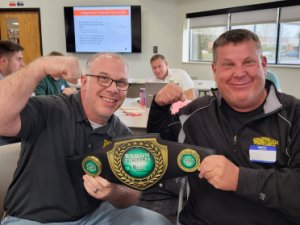
School staff become #RadonFighters at an EAIS Radon Kickoff.
As the new guy around the Energy Association of Iowa Schools (EAIS) office, I’m in heavy duty learning mode. Because there’s a lot I didn’t know about this nimble organization’s to-do list. EAIS provides energy management, radon reduction, and facility management support to help school districts save budget dollars and lives. But what does that look like? In this second of a two-part series, I’ll take a look at EAIS’ work with radon testing.
Did you know that radon is the number two cause of lung cancer behind smoking? A naturally occurring radioactive gas that forms as uranium, thorium, or radium break down in rock, soil, and water, radon can be found anywhere, and the real trouble arrives when it builds up in houses or buildings. If you spend time in a house or building (like me, most of you do), there’s a chance you’re being exposed to this odorless, tasteless, and invisible gas, which is deemed a threat, even for nonsmokers.
Enter EAIS. EAIS is committed to reducing lung cancer by offering testing and support to Iowa schools. Because radon testing is the only way to know it’s there.
Did you know that radon testing and mitigation (if measured over 4 pCi/L—that’s four picocuries per liter of air for those of you, like me, who didn’t know) is the law for Iowa schools? It is! HF 2412, also known as the Gail Orcutt School Radon Safety Act, requires all Iowa public schools to test for radon every five years and to mitigate if elevated levels are detected. And there’s a deadline to get started: July 1, 2027.
Ready to get your school tested? Registration for our in-person October 15 Radon Kickoff in Cedar Rapids and October 29 Radon Kickoff in Johnston (for first-time schools) can be found here. Online trainings for repeat schools will be held on October 2 and October 4 via Zoom, and signup is available here.
